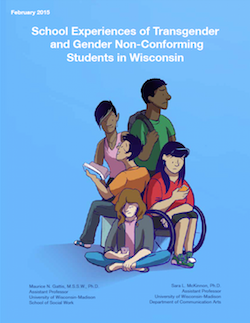Report: Transgender students need better support in Wisconsin schools
Transgender and gender nonconforming students report experiencing abusive, dismissive and disruptive treatment in the halls, classrooms and bathrooms of Wisconsin high schools.
But good experiences are not outside the norm, and relatively small changes to school policies and activities could go a long way toward improving the educational environment for these students, according to a first-of-its-kind report, “School Experiences of Transgender and Gender Non-Conforming Students in Wisconsin,” released recently by Madison-based nonprofit GSAFE and a pair of University of Wisconsin–Madison researchers.
“When we started this project in 2012, we knew two things,” says Brian Juchems, GSAFE’s senior director of education and policy. “Our transgender youth were not having a good time in school in our state, and there was not much data on how or why.”

A 2011 national report on discrimination experienced by transgender Americans of all ages found that 78 percent reported encountering harassment in their school years, and 15 percent left school due to harassment.
UW–Madison social work Professor Maurice Gattis and communication arts Professor Sara McKinnon worked with GSAFE to recruit high-school-aged interviewees from Green Bay, Madison, Milwaukee and Racine for focus groups to discuss their experiences in public schools as transgender and gender nonconforming students. The researchers also interviewed the parents of transgender youth in a Madison focus group.
“Not much is known about the experiences that shape the school environment for transgender and gender nonconforming students in Wisconsin — or anywhere,” says Gattis. “We need to hear what their stories are so we understand how to move forward. We want to think about a whole range of experiences: school facilities, health and wellness, school involvement, academic performance, social support, acceptance and social life.”
The findings outlined bullying and harassment, and also issues with school bathrooms and record keeping that alienate students by limiting their full inclusion.
Juchems was struck by the way the students described aggressive classmates, a problem frequent enough to make the transgender and gender nonconforming students feel they needed to be more aggressive in response.

Sara McKinnon and Maurice Gattis
“At least one of them said because they get harassed or bullied or teased, they have to make themselves tough,” Juchems says, “which sometimes means in order to defend themselves, they have to initiate something that leads to detention or a suspension.”
Among the most common issues were problems that might seem mundane: access to gender-affirming bathrooms and acknowledgement of preferred names and pronouns.
“Some school districts make it really challenging to be addressed by students’ preferred name and pronouns,” McKinnon says. “But there are some districts that make it easier to change your name in the registration system. That helps a lot, because when a substitute teacher comes into the classroom, they aren’t misnaming or misgendering these students.”
Bathroom access presents a similar challenge. Transgender and gender nonconforming students whose schools offer access to a gender-affirming bathroom often find themselves crossing the length of campus to use it. Others are relegated to using a bathroom in the school nurse’s office.
Among the most common issues were problems that might seem mundane: access to gender-affirming bathrooms and acknowledgement of preferred names and pronouns.
“We had one student who said the accommodation was to use a bathroom in the family restaurant across the street from their school,” Gattis says.
To improve the school environment for transgender and gender nonconforming students, the report recommends six things: the consideration of trans-affirming policies, training to help school staff support, supporting LGBTQ student organizations like a gay-straight alliance or other affirmative group, community education about gender diversity, adopting restorative discipline practices, and trans-inclusive health curricula.
“It was pretty clear that there are some school districts that are taking active steps to address the experiences of transgender and gender nonconforming youth, and the youth talked positively about those changes,” McKinnon says. “They say things like, ‘My school has taken these steps, and this is how it has improved my daily life.’ Or ‘Yes, I can go to my counselor, and talk about my experiences as a transgender person. And that person is open to have those conversations with me.’”
The researchers have extended their focus groups to include school staff in Wisconsin schools and plan to interview more students in rural Wisconsin schools as their work progresses. The full report is available via GSAFE’s website and the researchers’ university web pages.




